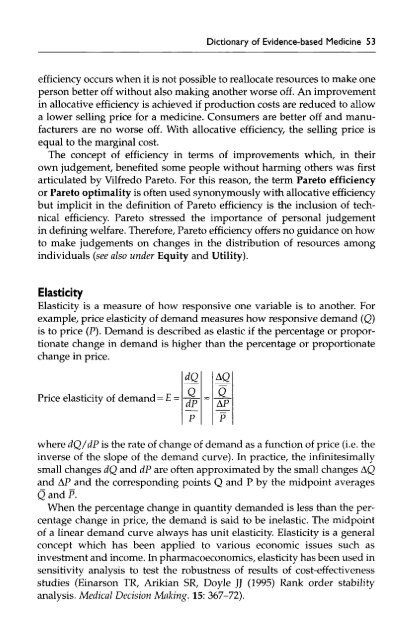Dictionary of Evidence-based Medicine.pdf
Dictionary of Evidence-based Medicine.pdf
Dictionary of Evidence-based Medicine.pdf
Create successful ePaper yourself
Turn your PDF publications into a flip-book with our unique Google optimized e-Paper software.
<strong>Dictionary</strong> <strong>of</strong> <strong>Evidence</strong>-<strong>based</strong> <strong>Medicine</strong> 53<br />
efficiency occurs when it is not possible to reallocate resources to make one<br />
person better <strong>of</strong>f without also making another worse <strong>of</strong>f. An improvement<br />
in allocative efficiency is achieved if production costs are reduced to allow<br />
a lower selling price for a medicine. Consumers are better <strong>of</strong>f and manufacturers<br />
are no worse <strong>of</strong>f. With allocative efficiency, the selling price is<br />
equal to the marginal cost.<br />
The concept <strong>of</strong> efficiency in terms <strong>of</strong> improvements which, in their<br />
own judgement, benefited some people without harming others was first<br />
articulated by Vilfredo Pareto. For this reason, the term Pareto efficiency<br />
or Pareto optimality is <strong>of</strong>ten used synonymously with allocative efficiency<br />
but implicit in the definition <strong>of</strong> Pareto efficiency is the inclusion <strong>of</strong> technical<br />
efficiency. Pareto stressed the importance <strong>of</strong> personal judgement<br />
in defining welfare. Therefore, Pareto efficiency <strong>of</strong>fers no guidance on how<br />
to make judgements on changes in the distribution <strong>of</strong> resources among<br />
individuals (see also under Equity and Utility).<br />
Elasticity<br />
Elasticity is a measure <strong>of</strong> how responsive one variable is to another. For<br />
example, price elasticity <strong>of</strong> demand measures how responsive demand (Q)<br />
is to price (P). Demand is described as elastic if the percentage or proportionate<br />
change in demand is higher than the percentage or proportionate<br />
change in price.<br />
Price elasticity <strong>of</strong> demand = £ =<br />
where dQ/dP is the rate <strong>of</strong> change <strong>of</strong> demand as a function <strong>of</strong> price (i.e. the<br />
inverse <strong>of</strong> the slope <strong>of</strong> the demand curve). In practice, the infinitesimally<br />
small changes dQ and dP are <strong>of</strong>ten approximated by the small changes AQ<br />
and AP and the corresponding points Q and P by the midpoint averages<br />
Q and P.<br />
When the percentage change in quantity demanded is less than the percentage<br />
change in price, the demand is said to be inelastic. The midpoint<br />
<strong>of</strong> a linear demand curve always has unit elasticity. Elasticity is a general<br />
concept which has been applied to various economic issues such as<br />
investment and income. In pharmacoeconomics, elasticity has been used in<br />
sensitivity analysis to test the robustness <strong>of</strong> results <strong>of</strong> cost-effectiveness<br />
studies (Einarson TR, Arikian SR, Doyle JJ (1995) Rank order stability<br />
analysis. Medical Decision Making. 15: 367-72).










